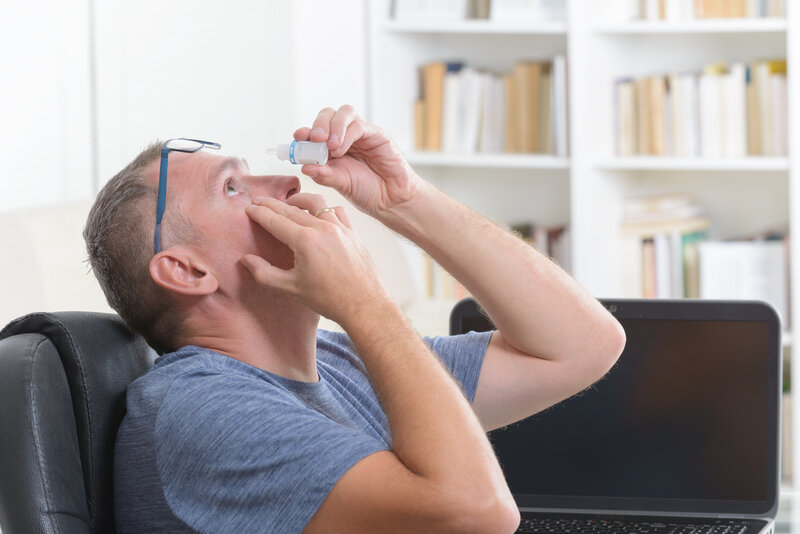Dry Eye Prevention And Treatment

In the past, dry eye was largely a condition found in seniors and postmenopausal women or as a side effect of certain medical conditions or medications. Now, as a result of the increased amount of time we spend on screens, optometrists are seeing more frequent cases of dry eye, even in our younger clientele.
Awareness and proactive prevention are the best ways to keep dry eye at bay or ensure a mild case doesn’t worsen. Always schedule an appointment with an optometrist if you experience consistent pain, discomfort, irritation, or other unusual symptoms with your eyes or vision.
You May Have Dry Eye If…
In our post, Dry Eye Symptoms and Relief, we go into these signs of dry eye in detail. The most common symptoms are:
- Your eyes feel dry
- Scratchy or irritated eyes - even when there’s nothing in them
- Redness/pink-tinged whites of the eye
- Excessive tearing (a hyper response to the eye’s dry sensation)
- Light sensitivity
- Blurred vision
- A constant feeling like you need to rub your eyes
Any of these symptoms warrant a visit to your eye doctor to determine the cause.
Causes & Risk Factors for Dry Eye
Healthy eyes have three forms of natural lubrication, all of which are produced and distributed through the tear ducts. These are fatty oils, an aqueous fluid, and mucous. These fluids are balanced in a way that keeps the eye moist, cleansed, and nourished. They also work to flush the eyes when foreign objects make their way onto the eye’s surface.
When the body doesn’t produce or circulate enough of this lubricant mixture through the tear ducts, the eyes’ surfaces become dry and irritated. You can also suffer from dry eye if your eyes don’t produce high-quality tears - those lacking any of the three required “ingredients.”
Common causes and risk factors for dry eye include:
- Being female
- Going through menopause
- Adults 50+
- Suffering from allergies
- Working or spending ample time in environments with high particulate matter or pollutants that irritate the eyes
- Autoimmune disorders
- Wearing contact lenses
- Lacking adequate vitamin A or omega 3 fatty acids
- Spending more than a couple of hours per day on the computer
That last bullet point is important, so we’re going to start there when it comes to dry eye prevention.
Dry Eye Prevention In Five Simple Steps
Fortunately, dry eye is largely preventable or, at least, easily managed in five simple steps.
Eat well and hydrate
Did you notice that lack of Vitamin A and Omega 3s were on that list of risk factors? What you eat matters to every aspect of your health - including vision. Eating nourishing foods and drinking plenty of good ol’ fashioned water go a long way toward giving your body everything it needs to be well.
This one foundational step not only lowers your risk of dry eye, but it also helps with weight management and the prevention of other diseases - many of which impact eye health and vision. Focus on a diet comprised of lean meats, healthy fish, and lots of fruits and veggies. Nuts and seeds are great, too.
Foods with the highest natural levels of Vitamin A include:
- Leafy greens (spinach, romaine, chard, kale, bok choy)
- Yellow and orange veggies (carrots, squash, sweet potatoes/yams, pumpkin)
- Tomatoes
- Red, yellow, and orange bell peppers
- Fish oils (also high in omega-3)
- Eggs
- Milk
If you feel you’re at risk for dry eye or you’ve already experienced symptoms, speak with your optometrist about supplements that support eye health.
Get plenty of sleep
Most adults in the United States suffer from chronic sleep deprivation, which leads to dry and irritated eyes. Establishing healthy sleep habits is a lifestyle choice with exponential benefits.
Practice healthy screen time habits
We recently published on how to prevent eye strain, emphasizing the 20-20-20 rule. The more you look at screens - computers, phones, tablets, and TV - the less you blink. Blinking is an autonomic nerve function - meaning you don’t have to think about it to do it. Unfortunately, when our brains are hyper-focused on screens, the autonomic system is lulled, leading to slower breaths and fewer blinks.
The less you blink, the drier your eyes become. Over time, it leads to chronic dry eye. When using screens, set a timer on your phone and take a stretch break every 20 minutes. While you’re at it, stare at something at least 20 feet away (a view of the outdoors is always nice!) for at least 20 seconds. Also, whenever you think about it, give your eyes a few extra blinks to give them an extra moisture boost.
Keep preservative-free eye drops at the ready
Using preservative-free (labeled on the bottle) eye drops on hand is another smart move. Anytime your eyes feel dry, or itchy, or you feel the urge to rub your eyes - use the drops instead.
Preservative-free drops are best. Many brands put chemicals in their drops to increase their shelf life. Unfortunately, these chemicals can irritate already sensitive eyes. Preservative-free options ensure you get all of the good hydration without any of the potential irritants.
NOTE: The use of a portable humidifier where you work or use screens can also help to support a more moist eye environment.
Make eyeglasses the staple and wear contacts sparingly for dry eye prevention
If you’re prone to dry or irritated eyes, we recommend wearing glasses as much as possible and wearing contacts for shorter durations. Contact lenses exacerbate dry eyes, so it’s worth putting them on the shelf for a while to see if that helps.
Schedule An Appointment For Dry Eye Treatment
If lifestyle changes aren’t enough to do the trick, your optometrist can prescribe special drops or ointments to support eye lubrication. In severe cases, we might also block the tear ducts using tiny silicone or gel-like plugs that keep tears in the eye for longer. Depending on existing eye inflammation, we might also recommend using warm, moist compresses and DIY eye massages to soothe irritated tissues.
Schedule an appointment at Eye to Eye Family Vision Care if you or a member of your family experiences symptoms of dry eye. We’ll work with you to get relief.

